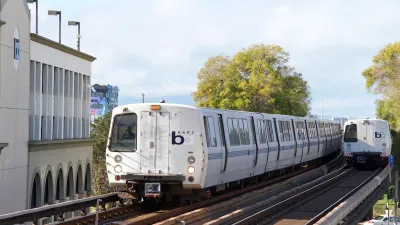Low-income transit users desperately need a break on fares. A discount is on its way, but won’t be available until later in the year, and transit advocates say it’s not enough.

Rachel Swan reports on the San Francisco Bay Area plan to provide a fare discount of 20 percent to low-income riders using BART, Caltrain, Muni, and Golden Gate ferries and buses. Implementation has been slow as the discount was approved last May but may not start until November.
Critics say the discount should be higher to address the economic hardships that low-income transit users are facing in the Bay Area, notes Swan:
Housing tends to be cheaper far away from job centers, which raises the price of commuting. For many people, it means more transfers, more complexity and more fares tacked on. And BART’s fare system, unlike that of some other metro rail lines, charges more for longer trips.
Advocates also say that other groups are already getting discounts — such as seniors and young people — and low-income riders should similarly get help in an area with an astronomical cost of living.
Transportation officials acknowledge that the cost of transit is a burden and the discount is just one step in the right direction. But they are concerned about how the agencies will cover their portions of the $20.7 million annual cost of the program without cutting back on services.
FULL STORY: Bay Area’s low-income transit riders, after long wait, to receive discounts

Alabama: Trump Terminates Settlements for Black Communities Harmed By Raw Sewage
Trump deemed the landmark civil rights agreement “illegal DEI and environmental justice policy.”

Study: Maui’s Plan to Convert Vacation Rentals to Long-Term Housing Could Cause Nearly $1 Billion Economic Loss
The plan would reduce visitor accommodation by 25% resulting in 1,900 jobs lost.

Why Should We Subsidize Public Transportation?
Many public transit agencies face financial stress due to rising costs, declining fare revenue, and declining subsidies. Transit advocates must provide a strong business case for increasing public transit funding.

Paris Bike Boom Leads to Steep Drop in Air Pollution
The French city’s air quality has improved dramatically in the past 20 years, coinciding with a growth in cycling.

Why Housing Costs More to Build in California Than in Texas
Hard costs like labor and materials combined with ‘soft’ costs such as permitting make building in the San Francisco Bay Area almost three times as costly as in Texas cities.

San Diego County Sees a Rise in Urban Coyotes
San Diego County experiences a rise in urban coyotes, as sightings become prevalent throughout its urban neighbourhoods and surrounding areas.
Urban Design for Planners 1: Software Tools
This six-course series explores essential urban design concepts using open source software and equips planners with the tools they need to participate fully in the urban design process.
Planning for Universal Design
Learn the tools for implementing Universal Design in planning regulations.
Smith Gee Studio
Alamo Area Metropolitan Planning Organization
City of Santa Clarita
Institute for Housing and Urban Development Studies (IHS)
City of Grandview
Harvard GSD Executive Education
Toledo-Lucas County Plan Commissions
Salt Lake City
NYU Wagner Graduate School of Public Service





























